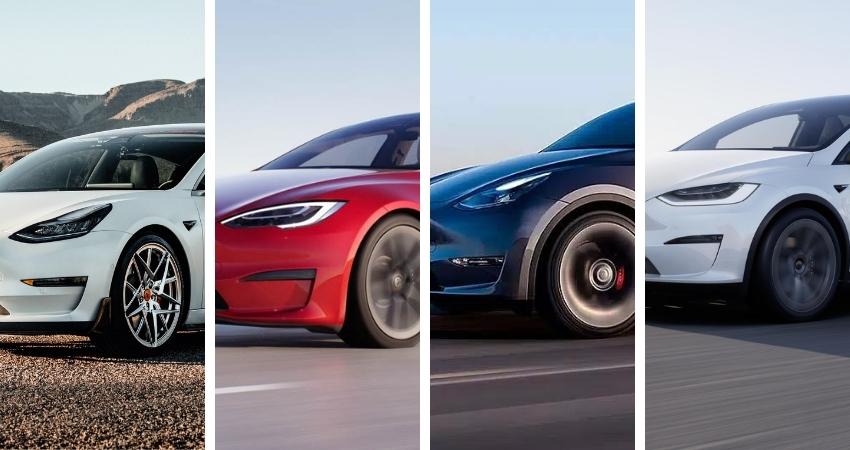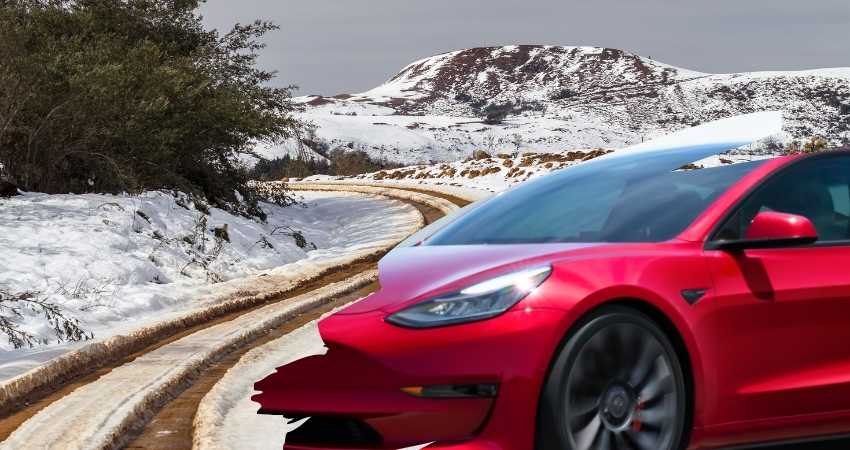Driving in snow is no less than an ordeal—moving through the roads in such weather requires a vehicle that can easily face all the visible and hidden stumbling blocks thrown by the snow. But since the general masses are illusioned by the myth that electric cars – including Tesla – are not powerful enough, it is thought Tesla cannot handle harsh weather. But the answer is somewhat surprising.
Yes – you can drive a Tesla in snow due to its fantastic traction engineering, which keeps the grip even on slippery surfaces, enough height above the ground to move through the deposited snow, and climate control features that keep the car systems and its passengers warm.
What Do Cars Need to Handle Snow Driving?
- Better Road Grip: Snow is slippery. Cars that cannot grab a good hold of snow might be dangerous for passengers, people, and property around them.
- Ground Clearance: The higher a car is from the road, the quicker it will wade through the snow. Low ground clearance, conversely, can increase the odds of getting stuck.
- Heating System: Snowy weather is freezing. A car must have a heating system to keep the passengers warm and avoid fogging on the front screen.
- Remote Heating: The owners should be able to heat their car remotely before entering it to avoid flu that induces due to sudden contact with freezing surfaces.
Read: Are Tesla Good for Long Road Trips? Yes. Here Is Why
Why Is Tesla Good for Driving in Snow?
Tesla Cars Have a Good Traction
On account of their mind-blowing engineering and design, traction control is a piece of cake for Tesla’s, helping them accelerate better and – most importantly – prevent slippages during snowy situations. Here is what works behind:
The Weight Distribution Magic
Unlike the common perception, the ideal weight distribution is not 50-50 percent on the front and the back – 40 on the front and 60 on the back. The former distribution works well for maintaining road grip in stationary cars, but for moving ones, the latter is required simply because hard brakes shift some load on the front wheels; in such situations, if the car is 40-60 balanced, it will automatically come closer to 50-50 balance for the time being – providing a superb grip.
Tesla do exactly this. Though they do not maintain the ideal weight distribution, Tesla cars do lie in the 40s on the front and 50s on the rear range, making them a good choice for staying in place on snowy surfaces. Tesla Model 3, for instance, maintains a 47-53 percent weight balance, and the Model Y has a 46-54 ratio. Tesla does not compromise this feature even in its all-wheel-drive cars, where the motor weight lies on the front too.
Heavier-Than-Average Design
A normal car of the same size weighs about 3,000 pounds, while Tesla’s stands above 4,000 pounds. Many design factors make it happen; however, as per the simple rule of Physics, the heavier weight has an added benefit of driving in snow by enhancing traction.
The Tesla Traction Control System
Traction control assists in preventing wheels from spinning on slippery paths. In turn, it puts forward a better road grip. If a car skids off the road or does not move forward due to a slippery surface, getting the help of such systems becomes vital.
Tesla’s traction control system is brilliant in doing its job – different reviews state that Tesla’s traction control is simply incomparable to internal combustion engine cars because of the quick and seamless power delivery. The system monitors the spinning of front and back wheels continuously, and if any discrepancy is found, it starts taking timely actions and gets the slipping vehicle moving in the correct direction.
All Wheel Drive
All-wheel drive helps cars wade through slippery surfaces by adding traction as all four wheels are powered instead of just two. If everything goes well and as planned, a car equipped with an all-wheel drive system does not disturb the traction control mechanism to come to the rescue. All Tesla models have an all-wheel drive feature that helps them easily navigate snowy roads.
Automatic Tesla Regenerative Braking System
The regenerative braking system can give a bit of a headache to electric car drivers because it might lead to the loss of traction in snowy conditions. However, Tesla handles the issue brilliantly. Tesla cars automatically minimize the regenerative feature when they notice a noticeable temperature drop.
Tires
Tires are among the most important parts of a car to maintain traction – after all, these have direct contact with the road. Winter tires have deep grooves that handle the snow better by compressing it, enhancing the grip and propulsion. A car should have winter tires or at least be capable of installing them.
Tesla offers winter tire packages for all its models. However, note that it is a ‘package’ that also includes the rims, costing much more than purchasing the tires. But users can have different winter tires installed on their existing rims. It is all about knowing the right size and quality. For instance, some sources claim that Michelin X-Ice Xi3 Winter Radial Tires work great for Tesla Model 3.
Tesla Has an Adequate Ground Clearance
Most Tesla models have enough ground clearance to navigate through city roads and streets if the snowfall is average.
In the condition described, as a general rule, any car at least four inches higher from the ground should face no obstacles. Tesla easily fulfills this criterion: the Model S is 4.6 inches high; the Model 3, 5.5; and the Model Y, 6.6. However, the Model X is exceptional – with 8.1 inches of ground clearance, this SUV can plow through the snow even if it falls heavily.
Tesla Cars Have Heaters
Tesla’s heating system can keep passengers warm and cozy in a freezing environment. And since the battery capacity might be affected in low temperatures, Tesla cars also have a feature to deal with that. Besides throwing warm air through different vents, the Tesla Climate Control can also make the seats warm and cozy.
| Preconditioning in Tesla
Tesla users can pre-heat their cars before hitting the road. While the car is still plugged in, use the app to do it – it will save a lot of energy while driving. |
Which Tesla Models Are Good for Driving in Snow?

- Model 3: The best part is that it comes with an all-wheel drive feature as a standard; the not-so-good point is that the ground clearance is inadequate to deal with heavy snowfall.
- Model S: It does not have a standard all-wheel drive for all variants, nor is its ground clearance impressive. But it is heavier, which adds to the traction, and it also has a good range, which is extremely useful when the regenerative braking system is turned off.
- Model Y: It is heavy with good ground clearance and range. The all-wheel drive feature also comes as standard for all variants.
- Model X: It is heavy and has a standard all-wheel drive feature for all variants. The best part: the ground clearance is impressive.
| Model | Weight (pounds) | Ground Clearance (inches) | Range (miles) | Standard All-Wheel Drive? |
| 3 | 3,682-4,048 | 5.5 | 262 | Yes |
| S | 4,651-4,776 | 4.6 | 405 | No |
| Y | 4,398 | 6.6 | 330 | Yes |
| X | 5,185-5,390 | 8.1 | 370 | Yes |
Some Tips for Driving a Tesla in Snow
- Always use the pre-conditioning feature before driving to conserve car energy and range.
- Keep an eye on the snowflake icon. It means that the battery is too cold to access its energy. Pre-conditioning should solve the issue; however, if the problem persists, contact a professional.
- Use a navigation system to stay alert if your route is congested due to heavy snowfall.
- Use defrost feature to avoid fogging on the windows.
- Remove snow from the handles by repeatedly bumping with your hand before you open the door.
- Defrost, and pre-conditioning features can also eliminate your car from a frozen charging port.
- Only use deicing washer fluid for cleaning the windshield.
Read: Tesla Rear Window Keeps Opening: Why? How to Fix it?
What Other Electric Car Can You Drive in Snow?
- Rivian R1T: This car can be adjusted to a crazy height of 14 inches above the road! Moreover, its 135-kWh battery can be driven for up to 314 miles on a single charge, making this truck an excellent option for people in colder regions.
- Mercedes-Benz EQC: This electric car is known for having little impact on the battery due to cold temperatures. It also has an all-wheel drive feature.
- Audi E-Tron Quattro: It has an all-wheel drive feature and a good ground clearance of 6.5 inches. Various reviews indicate that its drivers are more than happy thanks to the weight and traction control features.
Concluding Remarks: Can You Drive a Tesla in Snow?
Of course, you can drive a Tesla in the snow – thanks to its fantastic traction control, adequate ground clearance, and heating systems. Though all Teslas can do this job, the Model X seems the most promising. Moreover, sticking to some essential tips can make your road journey hassle-free in snowy weather. Have happy winter!


